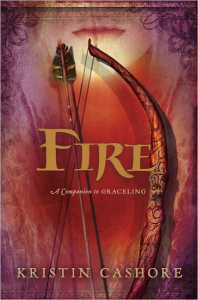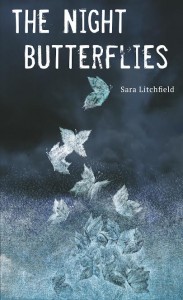Stories often feature characters who share traits or functions but use them in opposite ways. Think about Frodo Baggins and Gollum, Harry Potter and Voldemort, or Marianne and Elinor Dashwood. The characters in each pair reflect one another’s similarities while contrasting their differences in approaching those similarities. These pairs are known as “mirror characters” – and they serve a greater purpose than creating conflict.
Today’s edition of Theme: A Story’s Soul examines how mirror characters can illustrate literary themes. Like with our case study on trust, we’ll look at examples from two different books and see what techniques or storytelling elements come into play. So, in a way, we’ll discover how these examples “mirror” one another.
Mirror Characters and Power in Kristin Cashore’s Fire (YA Fantasy)
Fire tells the story of a young human-monster who struggles to accept her ability to control others’ minds. Fire’s experiences with two mirror characters – her monster father Cansrel (from whom Fire inherited her abilities), and King Nax’s adopted son Prince Brigan – respectively shape and reshape her views on power and choices.
tells the story of a young human-monster who struggles to accept her ability to control others’ minds. Fire’s experiences with two mirror characters – her monster father Cansrel (from whom Fire inherited her abilities), and King Nax’s adopted son Prince Brigan – respectively shape and reshape her views on power and choices.
Since Cansrel died prior to the beginning of Fire, readers learn about Cansrel and his days as royal advisor to King Nax through Fire’s memories. She recalls countless stories – many told to her by Cansrel himself – of how Cansrel used his powers to influence Nax’s drug dependence and to nearly run the kingdom into financial and political ruin. She also recounts the turbulent emotions she felt as a child toward her abilities and toward Cansrel, from pressure (“‘He means them as a lesson to guide my own behavior. It worries him that I don’t use my power as a weapon.’” [54]) to shame (“[S]he knew what she was and what she was capable of. Even after she’d done away with mirrors, she saw it in other people’s eyes…” [54]).
After Cansrel’s death, Fire vows to never exploit her powers for personal gain. So, it’s no surprise that she balks at the royal family’s request for help with political interrogations. Once Fire befriends Brigan, however, she finds a new “mirror.” Kind, generous, and soft-spoken, Brigan is the last man anyone would expect to be general of the royal army. He therefore understands Fire’s dilemma: “‘I know what it’s like to be capable of horrors. I’m training twenty-five thousand soldiers for a bloodbath. And there are things I’ve done I wish I’d never had to do…. ’” (212) Their conversation reminds Fire that Brigan chose to use his power wisely, unlike his step-father did. She then realizes that despite being Cansrel’s daughter, only she can choose how to use her powers.
Mirror Characters and Compassion in Sara Litchfield’s The Night Butterflies (Science Fiction / Dystopian)
 In The Night Butterflies, an isolated town in post-apocalyptic Great Britain must save their bioengineered children from a terrible fate. Their predicament, as well as the community’s struggle with compassion, leads readers to ask “What defines a monster?” – a question answered through three mirror characters:
In The Night Butterflies, an isolated town in post-apocalyptic Great Britain must save their bioengineered children from a terrible fate. Their predicament, as well as the community’s struggle with compassion, leads readers to ask “What defines a monster?” – a question answered through three mirror characters:
- Jimmy-1, a Batch #2 boy who, like his peers, looks like a normal human but has a learning disability, an infantile speech impediment, and a violent temperament.
- Ellie, the only survivor from Batch #1. Unlike Jimmy-1, she was born severely disfigured, and exudes warmth, concern for others, and an appetite for knowledge.
- Leader, the man in charge of the town, and the one who conceived the idea of bioengineered children – and who orders their annihilation.
Throughout The Night Butterflies, these three characters are branded as “monsters” of some kind. Jimmy-1 and his Batch #2 peers are called everything from “devils” (7) to “psychopaths” (31) for their pyromania and for physically abusing their own mothers. Later, the same children (except for Jimmy-1) taunt Ellie over her deformities. It’s clear, however, that everyone fears Leader. Separating married couples, drugging mothers into near-comas, burning alive anyone who opposes his will – there’s no question that he lacks compassion.
As for Jimmy-1, his change of heart begins when he meets Ellie. Instead of being disgusted by her looks, he’s curious about her. His willingness to learn from Ellie grows increasingly evident in their scenes together. Thus, Jimmy-1 learns a great deal from his new friend, especially the power of empathy: “Ellie started to cry. I dint like it. I dint care before when people cry, not Teacher, not my Mother, but this maked my tummy feel funny. It maked me want to cry as well.” (136)
Keys to Using Mirror Characters to Explore Theme
Interactions between mirror characters are essential in exploring theme. Both Fire and The Night Butterflies accomplish this through the following techniques and elements:
- Using Multiple Mirror Characters: Cansrel and Brigan are two of Fire’s several mirrors of power. The same goes for Ellie and Leader with Jimmy-1 and compassion. Presenting at least two mirror characters will give the protagonist more opportunities to learn and will strengthen his/her evolution with the theme at hand.
- Comparisons: Fire and Jimmy-1 explicitly reflect on how they’re different from their respective mirror characters. Using clearly stated comparisons allows readers to see what the protagonist sees and better understand the inner conflict and, therefore, theme.
- Dialogue: It’s human nature to talk through problems so we can find solutions. Fire in particular converses with other characters about her father and the ethics of her abilities, which helps her consider every angle of her struggle with power.
- Thoughts and Reactions: A character arc succeeds when readers see how a protagonist’s behaviors and thinking patterns have changed. When Jimmy-1 is moved by Ellie’s sadness and acknowledges its effect on him, readers know his transformation is complete.
Remember that the chief role of mirror characters is to show how they’re thematic opposites. Jimmy-1, who initially lacks compassion, becomes more caring by appreciating Ellie’s kindness toward him and by observing Leader’s complete rejection of the idea through killing off the other children. Fire reevaluates her sense of power by comparing Cansrel’s abuse of his mind-altering abilities with Brigan’s acceptance of and mindfulness toward his military role. And by reflecting on these mirror characters, each protagonist evolves and lets theme shine through.
It’s Your Turn!
- Have you read any novels featuring mirror characters? What themes do they demonstrate, and how?
- Both Fire and The Night Butterflies deal with characters who are considered “monsters” in appearance or personality. Have you read other books that explore what it means to be a “monster”?
- Do any stories you’ve written include mirror characters? Share your examples below.
What are some topics you’d like to see featured at Theme: A Story’s Soul? Share your thoughts by commenting below or tweeting me at @SaraL_Writer with the hashtag #AStorysSoul.
…………….
 u is a Massachusetts-based writer who practices joy and versatility in her work. In addition to writing a fantasy novel, she reviews tea at A Bibliophile’s Reverie and is a guest contributor for Grub Street Daily. She’s also a published poet whose works have appeared in The Curry Arts Journal, Soul-Lit, The Eunoia Review, Underground Voices, and two anthologies. Learn more about Sara at her personal blog, Facebook, and Twitter.
u is a Massachusetts-based writer who practices joy and versatility in her work. In addition to writing a fantasy novel, she reviews tea at A Bibliophile’s Reverie and is a guest contributor for Grub Street Daily. She’s also a published poet whose works have appeared in The Curry Arts Journal, Soul-Lit, The Eunoia Review, Underground Voices, and two anthologies. Learn more about Sara at her personal blog, Facebook, and Twitter.






